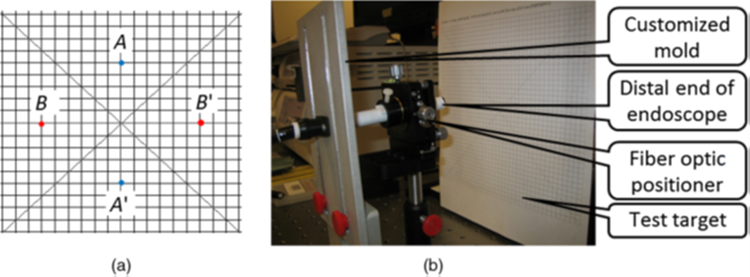Catalog of Regulatory Science Tools to Help Assess New Medical Devices
This regulatory science tool presents a lab method to quantitatively and objectively evaluate endoscope geometric distortion.
Technical Description
Current methods to evaluate endoscope geometric distortion are either too difficult to understand or too simple to accurately describe complex geometric distortion. The method overcomes these limitations, has clear physical meaning, and can facilitate lesion size estimation during diagnosis.
As one of the several important optical performance characteristics, endoscope geometric distortion can negatively affect size estimation and feature identification related diagnosis. Therefore, a quantitative and simple method to evaluate endoscope geometric is imperative for both the endoscope industry and medical device regulatory agents.

Fig. Distortion measurement setup: (a) test target and (b) test setup
Intended Purpose
The tool can be used to measure and compare geometric distortion of endoscopes. While the tool was original designed for measuring geometric distortion of endoscopes, it can be extended to any optical imaging cameras.
Testing
The method has been evaluated with an endoscopic system (Olympus EVIS EXERA II). Details are described in peer-reviewed publication: Development of the local magnification method for quantitative evaluation of endoscope geometric distortionExternal Link Disclaimer.
Limitations
Most endoscopes have geometric distortion that are circularly symmetric (that is, rotationally symmetric with respect to any angle). If an endoscope has defects and thus doesn’t have a symmetric distortion, the evaluation should be performed in different directions (for example, horizontal, vertical, diagonal) and the results should be compared.
Supporting Documentation
- The codes packageExternal Link Disclaimer for this method can be found at GitHubExternal Link Disclaimer. The package includes a license file, a user manual, a main script, a folder for subroutines, a folder for some input images and a folder for output data. Running the codes requires installation of the MATLAB software. Or the user can translate the codes to other languages.
- Scientific details about the tool can be found in peer-reviewed publication: Development of the local magnification method for quantitative evaluation of endoscope geometric distortionExternal Link Disclaimer
Contact
Tool Reference
- In addition to citing relevant publications please reference the use of this tool using RST24MD05.01
Note: This tool was previously listed in the catalog as “Quantitative evaluation of endoscope geometric distortion.”
